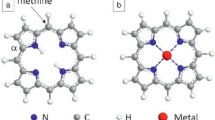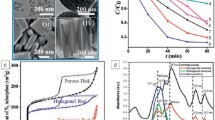Abstract
Recent developments of supramolecular bar-shaped molecular architectures of porphyrins are widely described. The utilization of synthetic and supramolecular techniques enables one to effectively organize molecular aggregates, which possess light energy conversion functionalities such as light harvesting, charge separation, and carrier transport. In the photovoltaic and photocalytic (hydrogen evolution) measurements, these highly organized architectures quantitatively exhibit drastic enhancements of light energy conversion properties as compared to the reference non-organized system.
Access this chapter
Tax calculation will be finalised at checkout
Purchases are for personal use only
Similar content being viewed by others
References
Dennler G, Scharber MC, Brabec CJ (2009) Polymer-fullerene bulk-heterojunction solar cells. Adv Mater 21(13):1323–1338
Grätzel M (2009) Recent advances in sensitized mesoscopic solar cells. Acc Chem Res 42(11):1788–1798
Kamat PV, Tvrdy K, Baker DR, Radich JG (2010) Beyond photovoltaics: semiconductor nanoarchitectures for liquid-junction solar cells. Chem Rev 110(11):6664–6688
Gunes S, Neugebauer H, Sariciftci NS (2007) Conjugated polymer-based organic solar cells. Chem Rev 107(4):1324–1338
Imahori H, Umeyama T, Ito S (2009) Large π-aromatic molecules as potential sensitizers for highly efficient dye-sensitized solar cells. Acc Chem Res 42(11):1809–1818
Martinez-Diaz MV, de la Torre G, Torres T (2010) Lighting porphyrins and phthalocyanines for molecular photovoltaics. Chem Commun 46(38):7090–7108
McEvoy JP, Brudvig GW (2006) Water-splitting chemistry of photosystem ii. Chem Rev 106(11):4455–4483
Yamada Y, Miyahigashi T, Kotani H, Ohkubo K, Fukuzumi S (2012) Photocatalytic hydrogen evolution with ni nanoparticles by using 2-phenyl-4-(1-naphthyl)quinolinium ion as a photocatalyst. Energy Environ Sci 5(3):6111–6118
Maeda K, Domen K (2010) Photocatalytic water splitting: recent progress and future challenges. J Phys Chem Lett 1(18):2655–2661
Kubacka A, Fernández-García M, Colón G (2011) Advanced nanoarchitectures for solar photocatalytic applications. Chem Rev 112(3):1555–1614
Hasobe T (2013) Porphyrin-based supramolecular nanoarchitectures for solar energy conversion. J Phys Chem Lett 4:1771–1780
Hasobe T (2010) Supramolecular nanoarchitectures for light energy conversion. Phys Chem Chem Phys 12(1):44–57
Kalyanasundaram K, Kiwi J, Grätzel M (1978) Hydrogen evolution from water by visible light, a homogeneous three component test system for redox catalysis. Helv Chim Acta 61(7):2720–2730
Barber J (2009) Photosynthetic energy conversion: natural and artificial. Chem Soc Rev 38(1):185–196
Ozawa H, Sakai K (2011) Photo-hydrogen-evolving molecular devices driving visible-light-induced water reduction into molecular hydrogen: structure-activity relationship and reaction mechanism. Chem Commun 47(8):2227–2242
Hasobe T, Sakai H (2013) Preparation and photoelectrochemical properties of supramolecular assemblies of nanoscale carbon material composites. ECS J Solid State Sci Technol 2(10):M3015–M3022
Hasobe T (2012) Photo- and electro-functional self-assembled architectures of porphyrins. Phys Chem Chem Phys 14(46):15975–15987
Imahori H, Yamada H, Guldi DM, Endo Y, Shimomura A, Kundu S, Yamada K, Okada T, Sakata Y, Fukuzumi S (2002) Comparison of reorganization energies for intra- and intermolecular electron transfer. Angew Chem Int Ed 41(13):2344–2347
Araki Y, Ito O (2008) Factors controlling lifetimes of photoinduced charge-separated states of fullerene-donor molecular systems. J Photochem Photobiol C Photochem Rev 9(3):93–110
Gust D, Moore TA, Moore AL (2001) Mimicking photosynthetic solar energy transduction. Acc Chem Res 34(1):40–48
Drain CM, Smeureanu G, Patel S, Gong X, Garnod J, Arijeloyea J (2006) Porphyrin nanoparticles as supramolecular systems. New J Chem 30:1834–1843
Gong X, Milic T, Xu C, Batteas JD, Drain CM (2002) Preparation and characterization of porphyrin nanoparticles. J Am Chem Soc 124(48):14290–14291
Drain CM, Varotto A, Radivojevic I (2009) Self-organized porphyrinic materials. Chem Rev 109(5):1630–1658
Radivojevic I, Likhtina I, Shi X, Singh S, Drain CM (2010) Self-organized nanofibers and nanorods of porphyrins bearing hydrogen bonding motifs. Chem Commun 46(10):1643–1645
Medforth CJ, Wang Z, Martin KE, Song Y, Jacobsen JL, Shelnutt JA (2009) Self-assembled porphyrin nanostructures. Chem Commun 47:7261–7277
Wang Z, Ho KJ, Medforth CJ, Shelnutt JA (2006) Porphyrin nanofiber bundles from phase-transfer ionic self-assembly and their photocatalytic self-metallization. Adv Mater 18(19):2557–2560
Wang H, Song Y, Medforth CJ, Shelnutt JA (2006) Interfacial synthesis of dendritic platinum nanoshells templated on benzene nanodroplets stabilized in water by a photocatalytic lipoporphyrin. J Am Chem Soc 128(29):9284–9285
Wang Z, Li Z, Medforth CJ, Shelnutt JA (2007) Self-assembly and self-metallization of porphyrin nanosheets. J Am Chem Soc 129(9):2440–2441
Martin KE, Wang Z, Busani T, Garcia RM, Chen Z, Jiang Y, Song Y, Jacobsen JL, Vu TT, Schore NE, Swartzentruber BS, Medforth CJ, Shelnutt JA (2010) Donor–acceptor biomorphs from the ionic self-assembly of porphyrins. J Am Chem Soc 132(23):8194–8201
Wang Z, Medforth CJ, Shelnutt JA (2004) Self-metallization of photocatalytic porphyrin nanotubes. J Am Chem Soc 126(51):16720–16721
Wang Z, Medforth CJ, Shelnutt JA (2004) Porphyrin nanotubes by ionic self-assembly. J Am Chem Soc 126(49):15954–15955
Lee SJ, Hupp JT, Nguyen ST (2008) Growth of narrowly dispersed porphyrin nanowires and their hierarchical assembly into macroscopic columns. J Am Chem Soc 130(30):9632–9633
Lee SJ, Mulfort KL, Zuo X, Goshe AJ, Wesson PJ, Nguyen ST, Hupp JT, Tiede DM (2008) Coordinative self-assembly and solution-phase x-ray structural characterization of cavity-tailored porphyrin boxes. J Am Chem Soc 130(3):836–838
Lee SJ, Jensen RA, Malliakas CD, Kanatzidis MG, Hupp JT, Nguyen ST (2008) Effect of secondary substituent on the physical properties, crystal structures, and nanoparticle morphologies of (porphyrin)sn(oh)2: diversity enabled via synthetic manipulations. J Mater Chem 18(31):3640–3642
Harada R, Matsuda Y, Okawa H, Kojima T (2004) A porphyrin nanotube: size-selective inclusion of tetranuclear molybdenum–oxo clusters. Angew Chem Int Ed 43(14):1825–1828
Fukuzumi S, Kojima T (2008) Photofunctional nanomaterials composed of multiporphyrins and carbon-based p-electron acceptors. J Mater Chem 18(30):1427–1439
Hu JS, Guo YG, Liang HP, Wan LJ, Jiang L (2005) Three-dimensional self-organization of supramolecular self-assembled porphyrin hollow hexagonal nanoprisms. J Am Chem Soc 127(48):17090–17095
Wang Z, Lybarger LE, Wang W, Medforth CJ, Miller JE, Shelnutt JA (2008) Monodisperse porphyrin nanospheres synthesized by coordination polymerization. Nanotechnology 19(39):395604
Floris H, Cameron CL, Marko MLN, Jeroen CG, Peter CMC, Antje L, George F, Philippe ELGL, Albertus PHJS, Meijer EW (2010) Dilution-induced self-assembly of porphyrin aggregates: a consequence of coupled equilibria. Angew Chem Int Ed 49(23):3939–3942
Ozawa H, Tanaka H, Kawao M, Uno S, Nakazato K (2009) Preparation of organic nanoscrews from simple porphyrin derivatives. Chem Commun 47:7411–7413
Elemans JAAW, Rv H, Nolte RJM, Rowan AE (2006) Molecular materials by self-assembly of porphyrins, phthalocyanines, and perylenes. Adv Mater 18(10):1251–1266
van Hameren R, Schon P, van Buul AM, Hoogboom J, Lazarenko SV, Gerritsen JW, Engelkamp H, Christianen PCM, Heus HA, Maan JC, Rasing T, Speller S, Rowan AE, Elemans JAAW, Nolte RJM (2006) Macroscopic hierarchical surface patterning of porphyrin trimers via self-assembly and dewetting. Science 314(5804):1433–1436
Lensen MC, Elemans JAAW, Dingenen SJTV, Gerritsen JW, Speller S, Rowan AE, Nolte RJM (2007) Giant porphyrin disks: control of their self-assembly at liquid-solid interfaces through metal-ligand interactions. Chem Eur J 13(28):7948–7956
de Pieter AJ, Witte CM, Cornelissen JJLM, Scolaro LM, Nolte RJM, Rowan AE (2003) Helical polymer-anchored porphyrin nanorods. Chem Eur J 9(8):1775–1781
Lensen MC, Takazawa K, Elemans JAAW, Jeukens CRLPN, Christianen PCM, Maan JC, Rowan AE, Nolte RJM (2004) Aided self-assembly of porphyrin nanoaggregates into ring-shaped architectures. Chem Eur J 10(4):831–839
Hasobe T, Oki H, Sandanayaka ASD, Murata H (2008) Sonication-assisted supramolecular nanorods of meso-diaryl-substituted porphyrins. Chem Commun 6:724–726
Hasobe T, Hattori S, Kamat PV, Urano Y, Umezawa N, Nagano T, Fukuzumi S (2005) Organization of supramolecular assemblies of fullerene, porphyrin and fluorescein dye derivatives on tio2 nanoparticles for light energy conversion. Chem Phys 319(1–3):243–252
Makiura R, Motoyama S, Umemura Y, Yamanaka H, Sakata O, Kitagawa H (2010) Surface nano-architecture of a metal-organic framework. Nat Mater 9(7):565–571
Motoyama S, Makiura R, Sakata O, Kitagawa H (2011) Highly crystalline nanofilm by layering of porphyrin metal-organic framework sheets. J Am Chem Soc 133(15):5640–5643
Sakuma T, Sakai H, Hasobe T (2012) Preparation and structural control of metal coordination-assisted supramolecular architectures of porphyrins. Nanocubes to microrods. Chem Commun 48(37):4441–4443
Sandanayaka ASD, Araki Y, Wada T, Hasobe T (2008) Structural and photophysical properties of self-assembled porphyrin nanoassemblies organized by ethylene glycol derivatives. J Phys Chem C 112(49):19209–19216
Schlenker CW, Thompson ME (2011) The molecular nature of photovoltage losses in organic solar cells. Chem Commun 47(13):3702–3716
Peet J, Heeger AJ, Bazan GC (2009) ‚äúplastic‚äù solar cells: self-assembly of bulk heterojunction nanomaterials by spontaneous phase separation. Acc Chem Res 42(11):1700–1708
Sun S-S, Sariciftci NS (2005) Organic photovoltaics. Taylor & Francis, Boca Raton
Sandanayaka ASD, Murakami T, Hasobe T (2009) Preparation and photophysical and photoelectrochemical properties of supramolecular porphyrin nanorods structurally controlled by encapsulated fullerene derivatives. J Phys Chem C 113(42):18369–18378
Hasobe T, Sandanayaka ASD, Wada T, Araki Y (2008) Fullerene-encapsulated porphyrin hexagonal nanorods. An anisotropic donor-acceptor composite for efficient photoinduced electron transfer and light energy conversion. Chem Commun (29):3372–3374
Hasobe T, Sakai H, Mase K, Ohkubo K, Fukuzumi S (2013) Remarkable enhancement of photocatalytic hydrogen evolution efficiency utilizing an internal cavity of supramolecular porphyrin hexagonal nanocylinders under visible-light irradiation. J Phys Chem C 117(9):4441–4449
Hasobe T, Imahori H, Fukuzumi S, Kamat PV (2003) Nanostructured assembly of porphyrin clusters for light energy conversion. J Mater Chem 13:2515–2520
Zhu X-Q, Yang Y, Zhang M, Cheng J-P (2003) First estimation of c4-bond dissociation energies of nadh and its radical cation in aqueous solution. J Am Chem Soc 125(50):15298–15299
Kotani H, Hanazaki R, Ohkubo K, Yamada Y, Fukuzumi S (2011) Size- and shape-dependent activity of metal nanoparticles as hydrogen-evolution catalysts: Mechanistic insights into photocatalytic hydrogen evolution. Chem Eur J 17(9):2777–2785
Imahori H, Kimura M, Hosomizu K, Sato T, Ahn TK, Kim SK, Kim D, Nishimura Y, Yamazaki I, Araki Y, Ito O, Fukuzumi S (2004) Vectorial electron relay at ito electrodes modified with self-assembled monolayers of ferrocene–porphyrin–fullerene triads and porphyrin–fullerene dyads for molecular photovoltaic devices. Chem Eur J 10(20):5111–5122
Acknowledgment
The author thanks and expresses gratitude to his collaborators and coworkers whose names appear in the references. This work was partially supported by Grants-in-Aid for Scientific Research (23108721 & 23681025), PRESTO project, Japan Science and Technology Agency (JST), and MEXT-Supported Program for the Strategic Research Foundation at Private Universities, 2009–2013. All figures, schemes, and tables are reproduced from the related references with permission of the American Chemical Society and the Royal Society of Chemistry.
Author information
Authors and Affiliations
Corresponding author
Editor information
Editors and Affiliations
Rights and permissions
Copyright information
© 2015 Springer Japan
About this chapter
Cite this chapter
Hasobe, T., Sakai, H. (2015). Supramolecular Porphyrin Nanorods for Light Energy Conversion. In: Akasaka, T., Osuka, A., Fukuzumi, S., Kandori, H., Aso, Y. (eds) Chemical Science of π-Electron Systems. Springer, Tokyo. https://doi.org/10.1007/978-4-431-55357-1_28
Download citation
DOI: https://doi.org/10.1007/978-4-431-55357-1_28
Publisher Name: Springer, Tokyo
Print ISBN: 978-4-431-55356-4
Online ISBN: 978-4-431-55357-1
eBook Packages: Chemistry and Materials ScienceChemistry and Material Science (R0)




